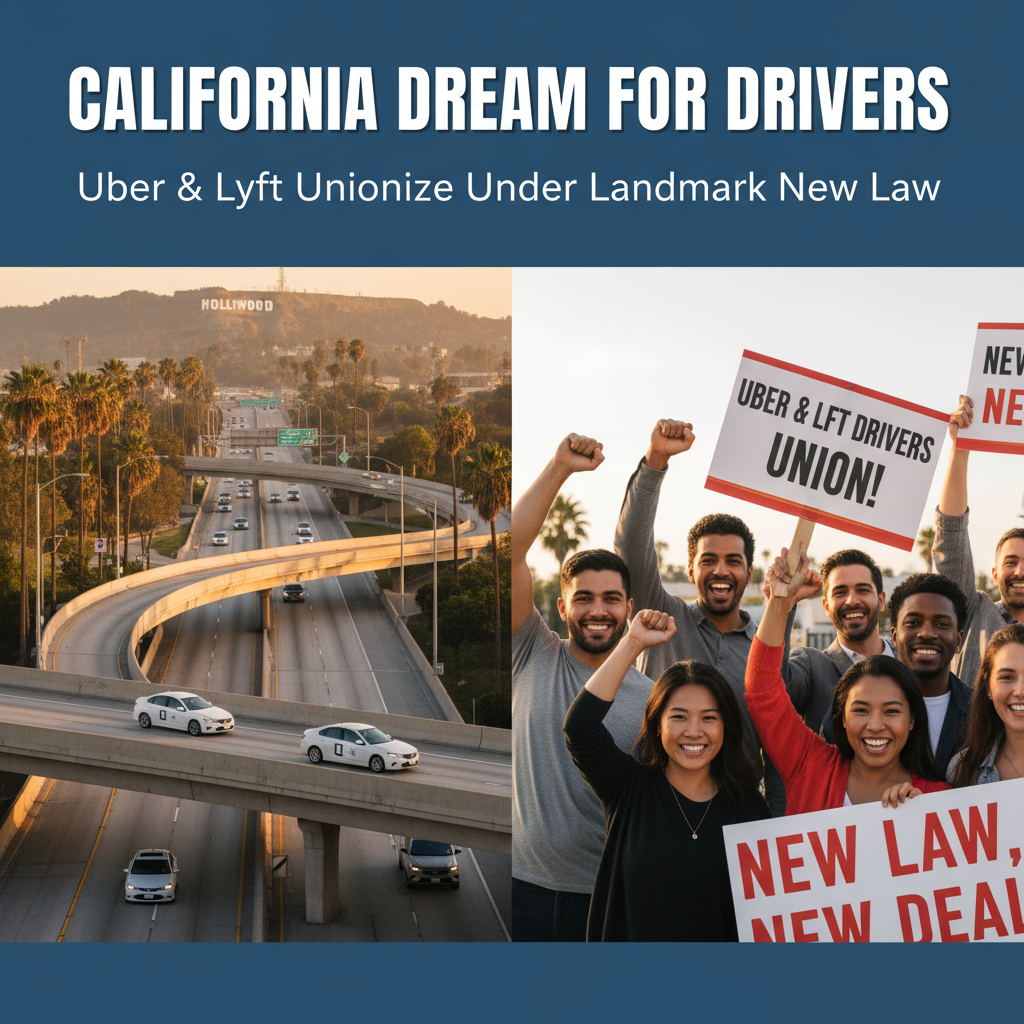Shifting Gears: California’s New Law Paves the Way for Uber and Lyft Driver Unionization
The Golden State is once again a trailblazer, this time in the ever-evolving landscape of the gig economy. In a significant move that could reverberate across the nation, California Governor Gavin Newsom recently signed landmark legislation granting Uber and Lyft drivers within the state the right to unionize. This isn’t just a win for hundreds of thousands of drivers; it’s a pivotal moment that challenges the traditional “independent contractor” model and redefines the future of work for many in the on-demand sector.
For years, rideshare drivers have navigated a precarious professional existence, caught between the flexibility they value and the lack of benefits and protections typically afforded to employees. This new law in California, following a similar move in Massachusetts, marks a monumental shift, potentially empowering a workforce that has long felt disempowered. Let’s delve into what this groundbreaking legislation means for drivers, the rideshare giants, and the future of labor relations.
A Historic Victory for Gig Workers’ Rights
The signing of this bill into law by Governor Newsom is the culmination of years of advocacy from driver groups, labor organizations, and progressive lawmakers. For too long, the classification of rideshare drivers as independent contractors has prevented them from exercising fundamental labor rights, including the ability to collectively bargain for better wages, working conditions, and benefits like healthcare and paid time off.
With over 800,000 rideshare drivers operating in California, this legislation has a massive impact. It establishes a clear legal framework for union certification, outlining the processes for drivers to organize, elect representatives, and engage in collective bargaining with companies like Uber and Lyft. This means drivers will no longer have to individually negotiate their terms of employment but can instead unite to demand fairer treatment and a more equitable share of the profits they help generate.
This California law isn’t an isolated incident. Massachusetts passed a similar measure in 2024, demonstrating a growing national trend towards recognizing the unique challenges faced by gig workers. These legislative actions are effectively creating a new category of worker, one that retains some flexibility but gains crucial labor protections typically reserved for traditional employees. It’s a nuanced approach that seeks to balance the innovation of the gig economy with the essential rights of its workforce.
What This Means for Drivers: A New Era of Empowerment
For the individual Uber and Lyft driver, this law represents a profound shift from a solo operator to a member of a collective. Imagine a scenario where drivers can negotiate for guaranteed minimum earnings rather than fluctuating fares, or advocate for transparent policies regarding deactivations and performance ratings. These are just a few examples of the tangible benefits that collective bargaining could bring.
Beyond monetary gains, unionization offers a voice. Drivers often feel like they have no recourse when issues arise with the platform, whether it’s a technical glitch impacting their earnings or a dispute with a rider. A union provides a formal channel for grievances, ensuring that drivers’ concerns are heard and addressed by management. This can lead to a more respectful and stable working environment, fostering a greater sense of fairness and job security.
Consider the potential for improved benefits. While drivers often value the flexibility of setting their own hours, the lack of health insurance, retirement plans, or even basic sick leave has been a significant point of contention. Collective bargaining could open the door to discussions about these essential benefits, potentially through employer contributions or innovative benefit structures tailored to the gig economy.
Challenges and the Road Ahead for Rideshare Companies
Naturally, this legislation presents significant challenges for Uber and Lyft. Their business models have historically relied on the independent contractor classification, which keeps labor costs lower and offers greater operational flexibility. Adapting to a landscape where drivers can unionize will require them to re-evaluate their operational strategies and potentially absorb increased labor costs.
One major hurdle will be the bargaining process itself. Union negotiations can be complex and protracted, requiring compromise on both sides. Rideshare companies will need to engage constructively with driver representatives and find solutions that work for both the business and its workforce. This could involve innovative approaches to benefits and compensation that acknowledge the gig economy’s unique structure.
Furthermore, this move in California could set a precedent for other states. If successful, the unionization of drivers in California might inspire similar legislative efforts elsewhere, leading to a broader shift in how gig economy companies operate nationwide. Uber and Lyft have historically invested heavily in lobbying efforts to maintain the independent contractor status of their drivers, and this new law indicates a significant pivot in that ongoing debate.
Conclusion: A Defining Moment for the Gig Economy
California’s decision to grant rideshare drivers the right to unionize is more than just a new law; it’s a landmark moment in the ongoing evolution of the gig economy. It signals a growing recognition that while the flexibility offered by platforms like Uber and Lyft is valuable, it should not come at the expense of fundamental worker rights and protections.
This legislation promises to bring greater stability, fairness, and a much-needed voice to hundreds of thousands of drivers. While the road ahead will undoubtedly involve negotiations and adjustments from both sides, this move sets a powerful precedent. It challenges the established norms of the gig economy and paves the way for a future where innovation and worker empowerment can coexist, ultimately leading to a more equitable landscape for all involved.
